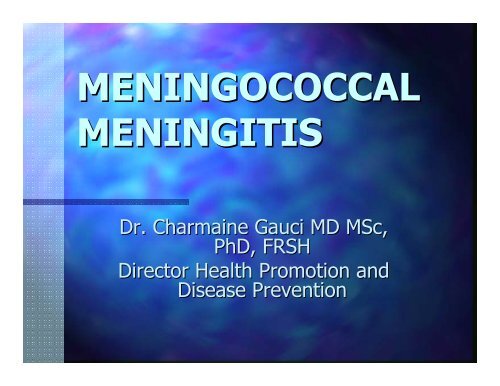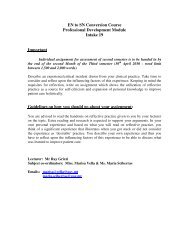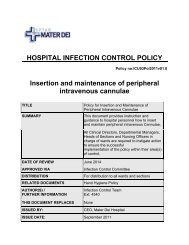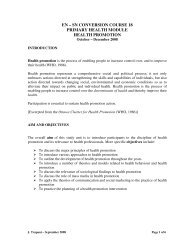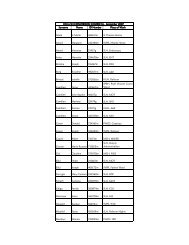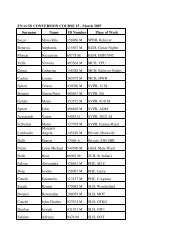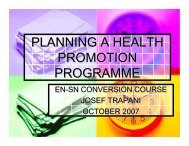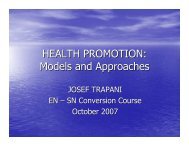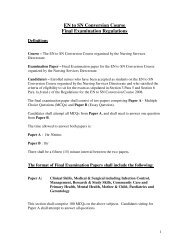MENINGOCOCCAL MENINGITIS
MENINGOCOCCAL MENINGITIS
MENINGOCOCCAL MENINGITIS
You also want an ePaper? Increase the reach of your titles
YUMPU automatically turns print PDFs into web optimized ePapers that Google loves.
<strong>MENINGOCOCCAL</strong><br />
<strong>MENINGITIS</strong><br />
Dr. Charmaine Gauci MD MSc, MSc,<br />
PhD, FRSH<br />
Director Health Promotion and<br />
Disease Prevention
Meningitis<br />
The meninges are the external<br />
coverings of the brain and the spinal<br />
cord. Inflammation of these covering<br />
membranes, commonly due to<br />
infection, is termed meningitis.<br />
Meningitis is typically associated with<br />
rapid onset headache, drowsiness,<br />
aversion to light and neck stiffness
Types of Meningitis
Diagnosis<br />
sample of spinal fluid collected by a<br />
needle (lumbar puncture) is tested to<br />
identify the type of meningitis and the<br />
causative agent.
Meningococcal Disease<br />
Severe bacterial infection of<br />
bloodstream or meninges<br />
Two common disease presentations<br />
Meningococcal meningitis<br />
Meningococcaemia
Meningococcal Disease<br />
Medical Emergency<br />
Urgent referral<br />
Urgent treatment<br />
Delay can be fatal<br />
Often get deaths from meningococcal<br />
disease
Aetiological agent<br />
The causative agent is Neisseria Neisseria<br />
meningitidis meningitidis which is a gram negative<br />
diplococcus.<br />
diplococcus.<br />
There are three main serotypes A, B,<br />
C.
Neisseria meningitidis<br />
Neisseria meningitidis<br />
3 serogroups - A, B, C
Neisseria meningitidis<br />
3 serogroups - A, B, C<br />
may invade to cause<br />
• meningitis (85%)<br />
• septicaemia (15%)
Transmission<br />
Neisseria Neisseria meningitidis<br />
meningitidis<br />
bacteria<br />
Only humans carry<br />
Neisseria Neisseria meningitidis<br />
meningitidis<br />
Person to person<br />
Inhalation of airborne<br />
droplets when infected<br />
person coughs/sneezes<br />
or close contact<br />
By carriers of Neisseria<br />
meningitidis
Nasopharyngeal carriage<br />
Neisseria Neisseria meningitidis meningitidis present mucosa<br />
of nose and throat<br />
Natural defence mechanisms contain<br />
infection<br />
Spread to other parts prevented<br />
? humoral immunity<br />
No symptoms seen
Who is at risk?<br />
Healthy individuals<br />
Increased risk in<br />
Children 6 months – 4 years<br />
Complement deficiencies<br />
Splenectomy patients<br />
Patients taking immunosuppressive drugs<br />
Current viral infection
Incubation period and<br />
Infectivity<br />
Incubation period: 2-10 2 10 days<br />
Infectivity period: as long as the<br />
organism is present in the nasopharynx.<br />
nasopharynx.<br />
Reservoir: is man and the organism<br />
dies quickly outside the host.
Signs and Symptoms<br />
Meningococcal Meningitis<br />
Children > 1 year and adults<br />
Neck stiffness<br />
Headache<br />
Nausea and vomiting<br />
Neck and/or back pain<br />
Fever/chills<br />
Increased sensitivity to light<br />
Irritability, confusion<br />
Children > 1 year and adults
Signs and Symptoms<br />
Meningococcal Meningitis<br />
Infants<br />
Refusing feeds<br />
Increased irritability<br />
Sleeping all the time<br />
Fever<br />
Bulging fontanelle<br />
Inconsolable crying<br />
Epileptic fits<br />
Usually respond well to antibiotics
Septicaemia<br />
Occurs in 10-20% 10 20% of cases<br />
Fever, pethechial rash, hypotension<br />
Seizures, coma possible<br />
CSF may be clear<br />
Progresses rapidly<br />
30% die: responds poorly to AB
Petechial rash
Rash
Necrotic rash
Signs and Symptoms<br />
Meningococcaemia<br />
Petechiae :<br />
rash of small red or purple spots that do not<br />
disappear when pressure is applied to skin<br />
Occurs in 50-75% 50 75% of cases<br />
Rash may progress to larger patches or purple<br />
lesions<br />
On trunk and extremities but any part<br />
Severe cases lesions may burst and lead to<br />
necrosis
Petechial rash
Petechial rash
Other signs and symptoms<br />
Acute fever and chills<br />
Headache<br />
Neck stiffness<br />
Low back and thigh pain<br />
Nausea and vomiting<br />
Confusion and unconsciousness<br />
Epileptic fits<br />
Collapse from septic shock
Meningococcal Disease<br />
Distribution:world wide distribution.<br />
Nasphargngeal carriage - about 10%<br />
prevalence lies somewhere between 2-4% 2 4%<br />
of the population rising to approximately<br />
20% in epidemic situations and over 50%<br />
in outbreaks in closed communities.<br />
Severe problem in “meningitis meningitis belt” belt in<br />
Africa
“Meningitis Meningitis belt” belt epidemics<br />
Serogroups A and C<br />
Neisseria Neisseria meningitidis<br />
meningitidis<br />
Begin in dry season;<br />
end when rainy season<br />
begins<br />
Children and young<br />
adults most affected<br />
70% of cases die<br />
without treatment<br />
10% of cases die with<br />
treatment
Meningococcal Disease<br />
in Malta<br />
Meningococcal disease has become a public<br />
health concern since 1996 when we<br />
experienced a steady increase in the<br />
incidence of the disease. From an incidence<br />
of 0.8 per 100,000 cases in 1994, the<br />
incidence reached 8.1 per 100,00 in year<br />
2000 and dropped to 4.4 per 100,000 in year<br />
2003.
Meningococcal disease<br />
Statuatory notifiable disease<br />
Physicians legal obligation (Public health<br />
Act)<br />
Medical diagnostic labs (MKPO)
Purpose of surveillance<br />
Detect outbreaks early<br />
Estimate the number of cases and<br />
deaths<br />
Assess size and geographic extent of<br />
outbreak<br />
Plan vaccination campaign<br />
Describe if control measures are<br />
working
Collect Information<br />
Record basic information<br />
Date, name, age, gender, address<br />
Record basic information<br />
Diagnosis and method of confirmation<br />
CLINICAL<br />
Diagnosis and method of confirmation<br />
LABORATORY<br />
Treatment<br />
LABORATORY<br />
Treatment<br />
Outcome<br />
Consider separate epidemic register during an<br />
epidemic (Attack rate substantially above the<br />
usual rate)
Importance of Public health<br />
management<br />
Reduce risk of disease (carriage in<br />
index and close contacts)<br />
Early identification of other cases<br />
Allay anxiety
Case ascertainment<br />
EU Case Definition (Decision ( Decision 2119/98<br />
EC)<br />
Clinical Description:<br />
Clinical picture compatible with<br />
meningococcal disease, e.g. meningitis<br />
and/or meningococcaemia/septicaemia<br />
meningococcaemia/septicaemia<br />
that may progress rapidly to purpura<br />
fulminans, fulminans,<br />
shock and death.<br />
Other manifestations are possible.
Case classification<br />
Confirmed case:<br />
A clinically compatible case diagnosed by one<br />
or more of the following laboratory criteria.<br />
Isolation of Neisseria Meningitidis from a normally<br />
sterile site<br />
Detection of N. meningitidis nucleic acid from a<br />
normally sterile site<br />
Detection of N. meningitidis antigen from a<br />
normally sterile site<br />
Demonstration of gram-negative<br />
gram negative diplococci from a<br />
normal sterile site by microscopy
Case classification<br />
Probable case:<br />
A clinical compatible case that is diagnosed<br />
by one or more of the following laboratory<br />
criteria:<br />
High titre of meningococcal antibody in<br />
convalescent serum<br />
Or<br />
Clinical picture compatible with<br />
meningococcal disease (clinical definition<br />
above) without any laboratory<br />
confirmation.
Other cases<br />
Clinical diagnosis of meningitis or septicaemia<br />
or other invasive disease where the public<br />
health physician, in consultation with the<br />
clinician & microbiologist, considers that<br />
diagnoses other than meningococcal disease<br />
are at least as likely.<br />
Cases here may be of viral origin but<br />
antibiotics may be given to case until<br />
diagnosis is confirmed.<br />
Follow up by public health physician re<br />
diagnosis and need for public health action
Family Slide
Cases in Contacts
Prophylactic treatment<br />
Risk assessment<br />
Index cases<br />
Household contacts<br />
Persons sleeping in the same household<br />
Pupils in the same dormitory<br />
Boy/girlfriends<br />
Childminder in homes
Prophylactic treatment..<br />
University students sharing a kitchen<br />
Persons in contact with case > 4 hours<br />
in a closed environment<br />
History of intimate kissing<br />
Passengers seated next to the index<br />
symptomatic case<br />
Health care workers
Prophylaxis NOT indicated<br />
Staff and children attending same nursery or<br />
crèche cr che<br />
Students/pupils in same school/class/tutor group<br />
Cheek kissing or mouth kissing<br />
Health care workers<br />
Pupils in other class rooms<br />
Friends and work colleagues<br />
Residents of nursing/residential homes<br />
Attending the same social function<br />
Food or drink sharing<br />
Exposure of eyes
Chemoprophylaxis :<br />
RIFAMPICIN<br />
For those over 12 years, the dose is 600mg (150 mg or 300mg preparations)<br />
twice daily for 2 days.<br />
For those under 12 years:
Chemoprophylaxis :<br />
CIPROFLOXACIN<br />
500 mg single dose in adults and<br />
children >12 yrs<br />
250mg for children 5-12 5 12 yrs<br />
125mg for children 2-4 2 4 yrs
Vaccines<br />
A, C, W135 or Y vaccines available<br />
close contacts who received<br />
chemoprophylaxis should be offered<br />
vaccination<br />
early as possible up to 4 weeks after<br />
the onset<br />
Mencavax AC (bivalent)<br />
Mencevax ACWY (quadrivalent<br />
quadrivalent) )
Dissemination of<br />
information<br />
Household contacts<br />
Group settings eg nurseries, schools<br />
Response team:<br />
Public health physician<br />
Environmental health inspector<br />
School health and safety officer<br />
School/group management
Information<br />
a case has occurred<br />
describe & give information on the disease<br />
(leaflet)<br />
the chances of having another linked case is<br />
very small<br />
should the symptoms and signs of<br />
meningitis occur, they should seek medical<br />
attention rapidly<br />
describe and give prophylaxis<br />
Inform parents & those being prescribed<br />
prophylaxis of possible side effects.
Managing clusters<br />
Assess the information<br />
Consider the options<br />
Make a decision<br />
Implement the decision<br />
usually information and antibiotics +/-<br />
vaccine to group at risk
Expected outcomes<br />
Accurate and timely information<br />
Alleviate fears<br />
Early identification of cases in contacts<br />
Compliance with control measures<br />
Response team to initiate control measures<br />
Reduce risk of disease<br />
Accurate and timely information<br />
Response team to initiate control measures<br />
Communication with media<br />
Information to general public : prevent panic and<br />
rumors<br />
Same key messages
Control Strategy<br />
Communicable disease strategy<br />
Meningococcal disease priority disease<br />
Actions for control at all levels:<br />
Management prior to referral to hospital<br />
Management on arrival at hospital<br />
Management prior to referral to hospital<br />
Management on arrival at hospital<br />
Laboratory Diagnosis<br />
Discharge and post discharge planning<br />
Surveillance<br />
Management of sporadic cases and<br />
outbreaks of meniningococcal disease
Meningococcal disease in<br />
Malta in 2006<br />
During the year 2006<br />
38 sporadic cases of MD were reported in<br />
Maltese residents.<br />
26 cases septicaemia<br />
12 cases meningitis
Case fatality rate<br />
Proportion of cases that resulted in<br />
death<br />
If CFR is >25%: problems with case<br />
management<br />
If CFR is
LOCAL SEROGROUP<br />
DISTRIBUTION<br />
Cases<br />
14<br />
12<br />
10<br />
8<br />
6<br />
4<br />
2<br />
0<br />
Meningococcal cases by serogroup (0-18 years)<br />
1999 2000 2001 2002 2003 2004 2005 2006<br />
Year<br />
MenB MenC Other
AGE SPECIFIC INCIDENCE RATES<br />
Incidence Rates of Laboratory Confirmed Invasive MenB<br />
disease by Age<br />
30<br />
25<br />
20<br />
Incidence/100,000 15<br />
10<br />
5<br />
0<br />
Public Health Strategy<br />
active surveillance of cases in hospitals for<br />
the early detection of suspected cases<br />
communication with the public and general<br />
practitioners<br />
early recognition and immediate treatment<br />
can save lives.<br />
Circulars were sent to doctors and patient<br />
information leaflets were distributed.
Thank you<br />
charmaine.gauci@gov.mt


